This article has multiple issues. Please help improve it or discuss these issues on the talk page. (Learn how and when to remove these messages)
|
| Battle of Wittstock | |||||||
|---|---|---|---|---|---|---|---|
| Part of the Thirty Years' War | |||||||
 | |||||||
| |||||||
| Belligerents | |||||||
| Sweden |
Holy Roman Empire Electorate of Saxony | ||||||
| Commanders and leaders | |||||||
| Strength | |||||||
| 17,000,[1] 60 guns | 18,000,[1] 32 guns | ||||||
| Casualties and losses | |||||||
| 3,500 dead or wounded,[2] 15 flags |
5,000[2] 2,000 dead, 3,000 captured, 32 guns, 151 flags and baggage | ||||||
The Battle of Wittstock took place during the Thirty Years' War (1618–1648). It was fought on 24 September (Julian calendar) or 4 October (Gregorian calendar) 1636. A Swedish-allied army commanded jointly by Johan Banér and Alexander Leslie decisively defeated a combined Imperial-Saxon army, led by Count Melchior von Hatzfeld and the Saxon Elector John George I.
Leslie and Banér commanded two distinct armies: Banér commanded the Swedish main army (huvudarmén), and Leslie commanded the Army of the Weser. Their subordinate officers included the Swedish Count and Major General Lennart Torstenson, Lieutenant General James King (later first Lord Eythin), and Major General John Ruthven. The latter is sometimes erroneously conflated with his uncle Patrick Ruthven who was also a Lieutenant General in the Swedish army, but not present at Wittstock.[3]
- ^ a b Wilson 2009, p. 582.
- ^ a b Wilson 2009, p. 583.
- ^ 'Rikskansleren Axel Oxenstiernas Skrifter och Brefvexling (Second Series, 13 vols., Stockholm, 1888– ), IX, pp. 465–468'